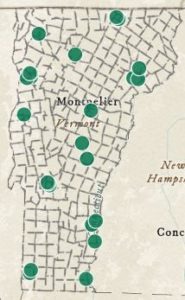As part of the 2017 Tax Cuts and Jobs Act, the new Opportunity Zones program provides tax incentives for investing in low-income communities. These zones are designed to spur economic development; they also have the potential to increase housing opportunity.
Earlier this month, the nonprofit research organization Urban Institute held a Chicago forum on “Leveraging Opportunity Zones for Community Benefit.” According to a Feb. 4 Shelterforce article about the forum by Tanner Howard, participants discussed how the availability of unsubsidized and unprotected affordable housing in these Opportunity Zone communities makes affordable housing preservation a potential focus for investors and that housing preservation could benefit long-term residents by ensuring greater safety and neighborhood vibrancy while boosting home values.
This is consistent with what we know about housing here in Vermont. We know that quality affordable and inclusive housing supports economic vitality and resilience by ensuring that people who work in our communities can afford to live here and by increasing the vibrancy and diversity of our communities.

Vermont has 25 designated Opportunity Zones in 17 communities – Barre City, Bennington, Brattleboro, Burlington, Johnson, Lyndon, Newport City, Randolph, Rockingham, Royalton, Rutland City, St. Albans City, St. Johnsbury, South Burlington, Springfield, Vergennes, and Winooski.
Combining the state’s designation and priority housing programs and/or tax increment financing with Opportunity Zone tax benefits could make a project that includes affordable housing even more attractive to investors – and more valuable to the community.
However, this new incentive is not a silver bullet for increasing affordable housing – or other economic development – in these communities.
Nick Grimley, Director of Entrepreneurship & Tech Commercialization at the Vermont Agency of Commerce and Community Development, explained that Opportunity Zone incentives aren’t a game-changer for financing, but that they could make a difference in terms of where projects are located. “If these projects would pencil out in an area that isn’t an Opportunity Zone,” Grimley said, “there is a greater benefit for the investor to locate it in the zone.”
The Opportunity Zone incentive program is still very new and Vermont investors and developers are waiting for the final federal regulations, which have been delayed because of the partial government shutdown.
One example of using the Opportunity Zone program in Vermont is the Putnam Block project in Bennington. According to Craig Miskovich of Downs Rachlin Martin PLLC, who is providing advice to the project development team, Bennington Redevelopment Group, LLC is using Opportunity Zone funding in conjunction with much larger, more complicated New Markets Tax Credits and Historic Tax Credits to revitalize the Putnam Hotel and the surrounding block.
The first phase of the four-acre redevelopment project, which is scheduled to start after an anticipated March closing date, will include retail, restaurant, and office space as well as more than two dozen apartments. A proposed second phase would include new buildings housing medical services, offices, and more housing. Miskovich explained that being in an Opportunity Zone makes it possible to harness equity funding from local, community-based sources and this means the Opportunity Fund benefits accrue to local investors.
Although Opportunity Zone incentives may not have a large impact in the overall cost of housing developments, they can make a big difference in the location of those developments and may be a piece of the puzzle of addressing Vermont’s affordable housing shortage in high-need areas.
RESOURCES FOR COMMUNITIES
- The Vermont Agency of Commerce and Community Development held an Opportunity Zone Summit to educate communities, investors, and potential project champions about the program in June 2018. You can find more info and the presentations here.
- This Dunkiel Saunders primer outlines the key Vermont land use laws and programs that can be used to enhance Opportunity Zone-financed development projects. The primer also includes a handy table listing which Opportunity Zone areas also have downtown, neighborhood, and village center designations.
- The Internal Revenue Service and U.S. Treasury Department are updating the Opportunity Zones guidelines first released in October 2018. This guidance, in the form of proposed regulations, a revenue ruling, and draft Form 8996, will be the subject of a public hearing on Feb. 14. There is a basic IRS Q & A about Opportunity Zones here.
Read the full Shelterforce article about the Chicago “Leveraging Opportunity Zones for Community Benefit” forum here.
Interesting. M&S Development also published a fact sheet indicating that Opportunity Zone equity generally doesn’t work well with tax credit programs like NMTC & LIHTC because it reduces basis, and may only be likely to come into play if not enough tax credit financing can be raised. I guess it’s the case in Bennington that they are using it as bridge financing to cover a tax credit gap. Or I could be wrong about all this which only serves to illustrate another point, which is that the program is incredibly complicated and that may be a bigger obstacle to QOZs realizing their full potential. Especially since the benefits start to go down after 2019 so there’s not much time to figure out a workable development model.